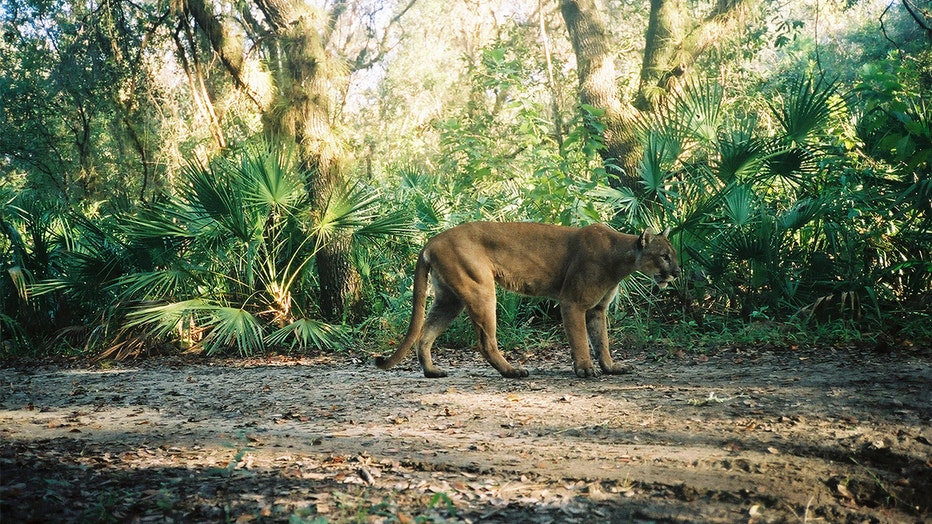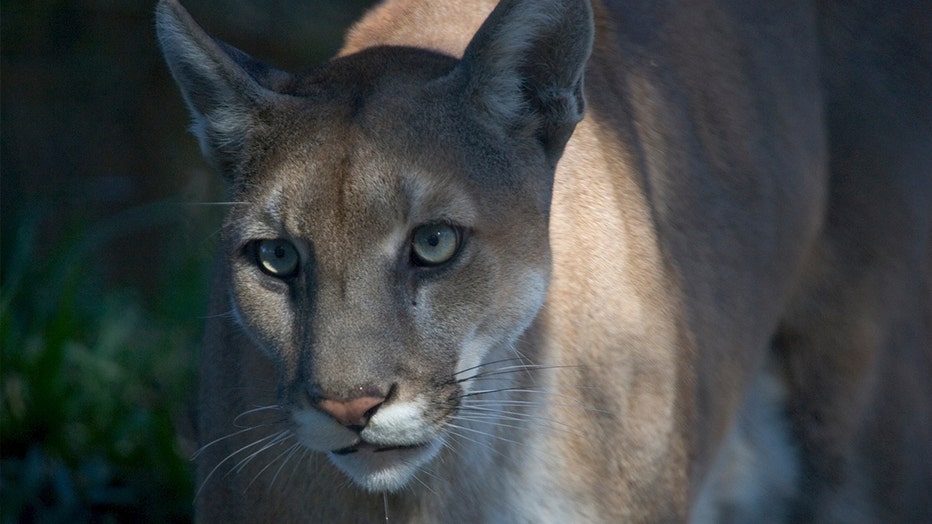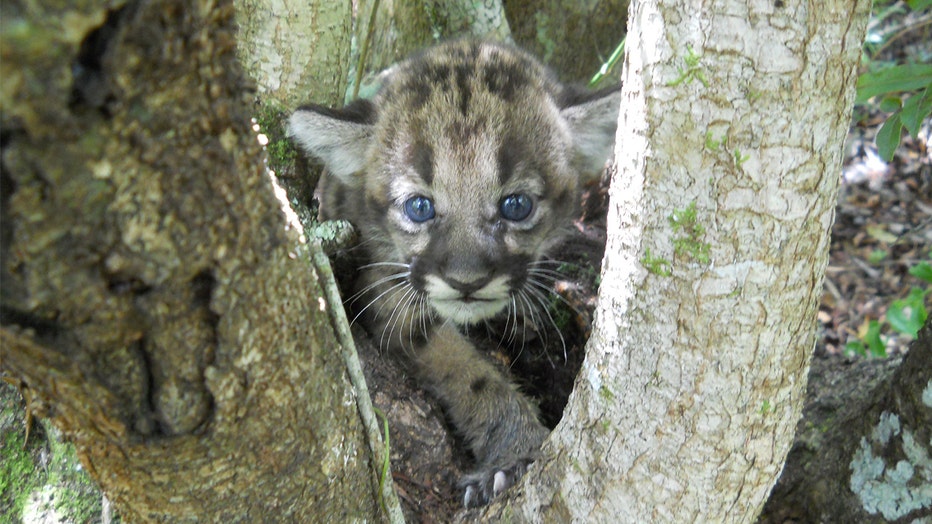Majority of Florida panther deaths in 2021 were due to vehicle crashes
Spotted: 'Healthy' panther kittens roam with mom in Florida wildlife refuge
Two young panthers were seen roaming the Florida Panther National Wildlife Refuge with their mom, 'Broketail.' So far, wildlife officials say the kittens appear healthy, showing no visible signs of the mysterious disorder that have been impacting Florida's wild cats.
The Florida panther, the official state animal, has been on the federal endangered species list since the 1960s, and in recent years, dozens have been killed annually – and it's mostly due to car accidents.
This year, wildlife officials recorded a total of 27 panther deaths. According to data from the Florida Fish and Wildlife Conservation Commission, 21 panthers – one as young as four months old – died after they were struck by a vehicle. Within the first month of the year, three young panthers were struck and killed by a vehicle. Within one day in September, FWC reported three were found dead.
Most of the deadly crashes occurred in Collier County, with 9 total.
Lee County, which shares a border with Collier County, had a total of 8 deaths. That's followed by Hendry County with 3 and Hardee County with 1.

In January 2012, a motion-activated camera captured an adult male Florida panther on the Florida Panther National Wildlife Refuge in Southwest Florida. (Provided by FWC)
The Florida Panther National Wildlife Refuge, operated by the U.S. Fish and Wildlife Service (FWS), is located in Collier County. Wildlife officials estimate between 120 to 230 Florida panthers remain in the wild.
"Habitat connectivity is also critical to the future of the panther population, so we continue to work with Florida Department of Transportation and other partners to improve and maintain safe habitat linkages across roadways," according to an FWC statement sent to FOX 13. "While panther vehicle collisions continue to be a concern, they are a symptom of a larger threat to wildlife populations: habitat loss.
Below is a breakdown of the 2021 panther deaths caused by vehicle collisions:
January 2
Age: 3 years old
Location: Terminal Access Road, 0.7 miles east of the intersection with Treeline Avenue
County: Lee
January 4
Age: 2 years old
Location: State Road 29, 0.7 miles north of County Road 858
County: Collier
January 21
Age: 2 years old
Location: State Road 82 at Rod and Gun Club Road
County: Lee
February 13
Age: 7 years old
Location: State Road 82, 0.6 miles SE of Daniels Parkways
County: Lee
March 10
Age: Unknown
Location: State Road 62, 1.4 mi. east of Brewster Road
County: Hardee
March 21
Age: 1.5 years old
Location: Interstate 75 at MM94
County: Collier
March 25
Age: 7 years old
Location: Chamberlin Parkway near Fort Myers Airport
County: Lee
April 10
Age: 1-year-old
Location: Immokalee Road, 2.75 mi. east of Oil Well Grade Road
County: Collier
April 12
Age: 1.5-year-old
Location: Interstate 75, MM 132
County: Lee
May 18
Age: 3.5 years old
Location: County Road 846, 1 kilometer west of County Line Road
County: Collier
May 27
Age: 2 years old
Location: State Road 29, 1/2 mile north of U.S. Highway 41
County: Collier
June 3
Age: 4 years old
Location: Church Road, five miles west of State Road 29
County: Hendry
June 4
Age: 2 years old
Location: State Road 29, 4.4 kilometers south of Interstate 75
County: Collier
July 9
Age: 2-3 (Unclear if it's by month or year, FWC website does not specify)
Location: Daniel's Parkway
County: Lee
August 25
Age: 8 years old
Location: State Road 82 near Corkscrew Road
County: Collier
September 28:
Age: 4-5 months old
Location: Turner River Road, 5.1 kilometers north of Wagon Wheel Road
County: Collier
Age: 3 years old
Location: State Road 29, 1 mile south of Interstate 75
County: Collier
Age: 10-12 years old
Location: Daniel's Parkway, 2 miles south of State Road 82
County: Lee
October 16
Age: 3 years old
Location: State Road 80, near Townsend Canal Road
County: Hendry
October 30
Age: 4 months old
Location: Corkscrew Road, 700 meters West of Alico Road
County: Lee
November 16
Age: 9 years old
Location: Keri Road
County: Hendry
Two panther deaths this year were due to "intraspecific aggression," or when a panther was killed by another panther. Two other panthers died from starvation on private property in Collier County. FWC officers were unable to determine the cause of death for two panthers, both found dead this year in Collier County.
The number of panther deaths caused by vehicle collisions is in line with a trend from previous years.
- 2020: 19 out of 22 total deaths this year were a result of vehicle crashes. One death was caused by a train collision.
- 2019: 23 out of 27 total deaths
- 2018: 26 out of 30 total deaths
- 2017: 24 out of 30 total deaths
- 2016: 34 out of 42 total deaths
- 2015: 30 out of 42 total deaths
- 2014: 24 out of 33 total deaths
FWS officials say if you're in an area where Florida panthers are known to roam, such as the Florida Panther National Wildlife Refuge, they ask motorists to drive slowly and increase the distance between other vehicles. Panthers are more active between dusk and dawn.
Why are panthers endangered?
In 1832, a bounty on panthers was created, and the species was heavily hunted. They were nearly extinct by the mid-1950s, according to the National Park Service (NPS).
They were once found as far west as Arkansas and as far north as South Carolina. Today, FWC believes there are as few as 120 panthers or as many as 230. Their current range is less than 5% of their original range.
Since 1967, the Florida panther has been on the federally endangered species list. As Florida's population increases and land is developed, the suitable habitat for panthers and other wildlife shrinks. Now, their primary threats are habitat loss, fragmentation, and degradation.
"Other factors include mortalities from collisions with automobiles, territorial disputes with other panthers, inbreeding, disease, and environmental toxins," according to NPS. "All these other factors, however, also are related to habitat reduction."

Photograph of Florida panther taken during winter or spring of 2006. (NPS photo)
They are concentrated in southwest Florida, but male panthers have been documented in other parts of the peninsula as they search for their own territories. However, most of the breeding population is in South Florida.
The NPS says natural gene exchange between the Florida panther and other Puma concolor species helped maintain "genetic health within populations and minimized inbreeding." However, inbreeding accelerated as the population declined and puma subspecies were isolated. For instance, the Florida panther no longer came in contact with the Texas panther.

In June 2013, this kitten was found nestled amongst a tangle of wax myrtle stems in Fakahatchee Strand Preserve State Park. (Photo: FWC)
As a result, there was genetic depression, declining health, reduced survivability, and a low number of Florida panthers. However, in 1995, wildlife officials launched a genetic restoration program. At that point, there were only 20 to 30 panthers living in the wild. That year, eight female Texas panthers were released in South Florida. Five of them had litters and at least 20 kittens were born.
By 2007, the Florida panther population tripled. The U.S. Fish and Wildlife Service will consider removing the Florida panther from the endangered species list when there are three populations of at least 240 individuals each – not included dependent-aged kittens. Also, there must be sufficient habitats to support them long-term.
"These recovery goals cannot be met without establishing additional populations outside of southern Florida," the FWC stated, "requiring support from private landowners."
READ: The Florida Panther Recovery Plan from FWS
Mystery illness impacting Florida's big cats
The deadly vehicle accidents are not the only concern among state wildlife officials. FWC continues to investigate the disorder, feline leukomyelopathy (FLM), which has been impacting Florida's big cats. The neurological condition has been causing Florida panthers and bobcats to stumble, lose their balance, and struggle to walk.
FWC first learned about the condition after receiving video of an affected kitten in spring 2018. It wasn't until 2019 when they received additional reports.
Trail cameras were installed to monitor panthers and determine if they are being impacted. As of March 2021, FWC has documented 8 bobcats and 3 panthers, along with 37 probable cases of FLM across Florida. The affected animals have different degrees of rear leg weaknesses.
The cause of FLM is not yet determined. Anyone who has photos or video showing wildlife that appear to have problems with their rear legs is asked to submit the content to MyFWC.com/PantherSightings. Dead or injured panthers can be reported to the FWC’s Wildlife Alert Hotline at 1-888-404-FWCC (3922).
From 2020: Mysterious panther disorder may be worse than thought
The Florida Fish and Wildlife Conservation Commission confirmed the condition is not just contained to South Florida and could be a widespread issue.
PREVIOUS: Neurological issue affecting Florida panthers more widespread than previously thought: FWC
Florida panther research is mostly funded through the Florida Panther Research and Management Trust Fund. If you've seen Floridians driving with a tag that has a panther photo, it's likely the "Protect the Panther" specialty license plate. Tag holders give an annual $25 donation to the panther research fund when they renew their registrations. More information can be found here.
Currently, it's unclear whether FLM is contagious or if panthers can die from it. FWC says they are unsure if there is a cure, "but we believe the condition is permanent."
They do not believe inbreeding is a cause since FLM has been noted among some bobcats.
Tracking panther population
This year, those same trail cameras showed promising signs for the panther population. In April, biologists say cameras at Babcock Ranch Preserve in Charlotte County captured what was likely the first-ever images of panthers mating.
"Breeding success north of the Caloosahatchee River is critical to the long-term viability of the Florida panther population," according to a Facebook post by FWC, "so we are hopeful that this mating event resulted in a litter of kittens that would have been born around Nov 22nd. If so, they would be expected to emerge from the den in January 2022."
In September, two young panthers were seen roaming the Florida Panther National Wildlife Refuge with their mom, "Broketail." At the time, wildlife officials said the kittens appeared healthy. It was the second litter of 2021 kittens that have been photographed.
FWC is also asking for people to report any panther sighting to improve their "knowledge of panther distribution in Florida." Sightings can be reported through the FWC website.

